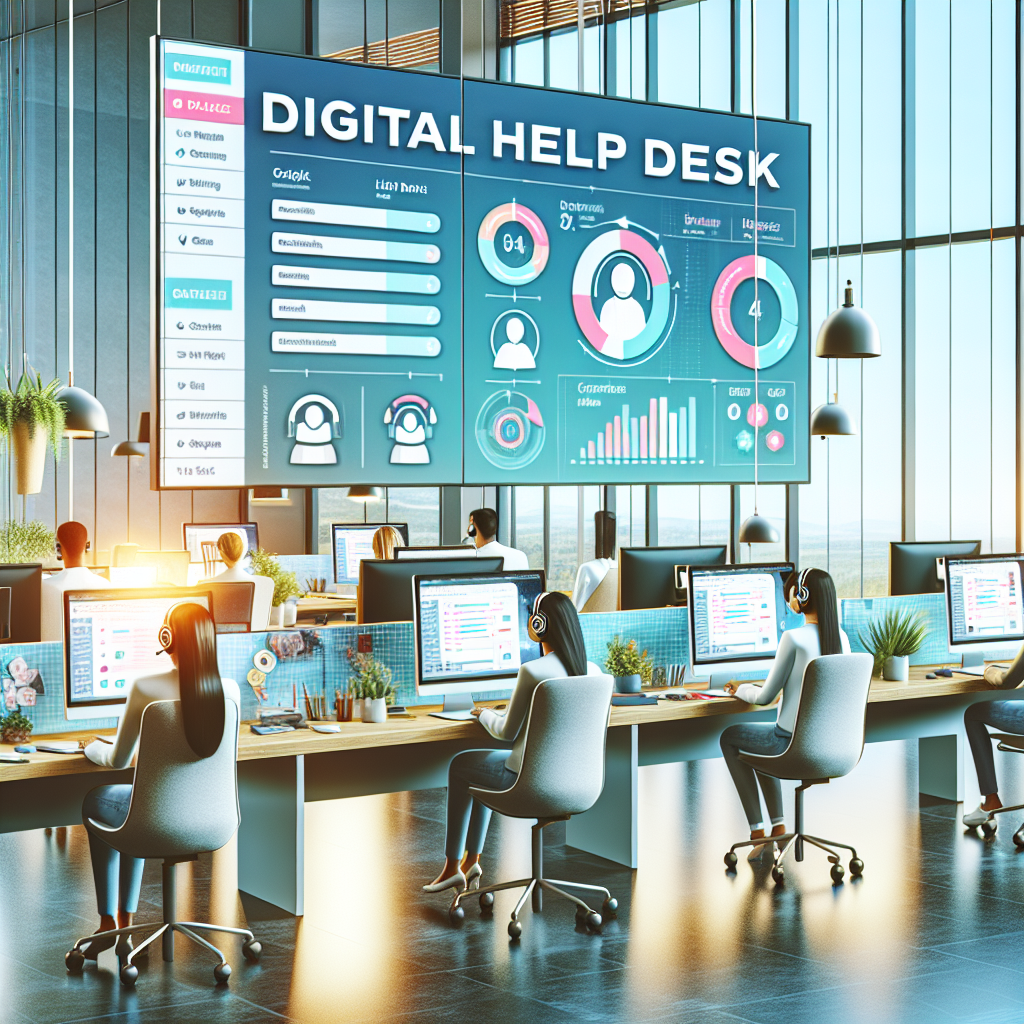Your cart is currently empty!
Tag: Desk

Top Help Desk Software Solutions for Streamlined Customer Support
In today’s fast-paced business environment, providing exceptional customer support is crucial for maintaining customer satisfaction and loyalty. One of the key tools that businesses can use to streamline their customer support processes is help desk software. Help desk software enables businesses to efficiently manage customer inquiries, track issues, and provide timely resolutions.Here are some of the top help desk software solutions that businesses can consider to streamline their customer support:
1. Zendesk: Zendesk is a popular help desk software solution that offers a comprehensive set of features for managing customer inquiries and support tickets. It includes features such as ticket management, live chat support, knowledge base, and reporting tools. Zendesk is known for its user-friendly interface and customizable workflows, making it a great choice for businesses of all sizes.
2. Freshdesk: Freshdesk is another top help desk software solution that offers a range of features for managing customer support. It includes features such as ticket management, automated workflows, multi-channel support, and reporting tools. Freshdesk is known for its ease of use and quick setup, making it a popular choice for small and medium-sized businesses.
3. Salesforce Service Cloud: Salesforce Service Cloud is a comprehensive customer service platform that includes help desk functionality. It offers features such as case management, knowledge base, live chat support, and social media integration. Salesforce Service Cloud is known for its scalability and integration capabilities, making it a great choice for large enterprises.
4. Jira Service Desk: Jira Service Desk is a help desk software solution designed for IT teams that need to manage customer support for their organization. It offers features such as ticket management, automation rules, SLA management, and reporting tools. Jira Service Desk is known for its integration with other Atlassian products, making it a great choice for organizations that already use Atlassian tools.
5. Zoho Desk: Zoho Desk is a help desk software solution that offers a range of features for managing customer support. It includes features such as ticket management, knowledge base, live chat support, and reporting tools. Zoho Desk is known for its affordability and ease of use, making it a popular choice for small businesses.
In conclusion, help desk software solutions play a crucial role in streamlining customer support processes and improving customer satisfaction. Businesses can choose from a range of top help desk software solutions based on their specific needs and budget. By investing in the right help desk software, businesses can provide efficient and effective customer support, leading to increased customer loyalty and retention.

How to Improve Your Help Desk Efficiency: Tips and Strategies
In today’s fast-paced business environment, having an efficient help desk is crucial for providing excellent customer service and resolving issues quickly. A well-functioning help desk not only increases customer satisfaction but also saves time and resources for your organization. If you’re looking to improve your help desk efficiency, here are some tips and strategies to consider:1. Implement ticketing system: A ticketing system is a centralized platform where all customer requests and issues are logged, tracked, and resolved. This system helps streamline communication, prioritize tasks, and ensure that no request falls through the cracks. By using a ticketing system, you can easily assign tasks to the appropriate team members, monitor progress, and provide timely updates to customers.
2. Provide comprehensive training: Proper training is essential for help desk agents to handle various customer inquiries and troubleshoot technical issues effectively. Make sure your team is well-versed in your products or services, familiar with common troubleshooting techniques, and equipped with the necessary tools and resources to assist customers. Regular training sessions and continuous learning opportunities can help improve the skills and knowledge of your help desk agents.
3. Automate repetitive tasks: Automation can significantly increase help desk efficiency by reducing manual tasks and allowing agents to focus on more complex issues. Consider implementing chatbots for handling frequently asked questions, setting up self-service portals for customers to find solutions on their own, and using AI-powered tools for analyzing customer data and predicting potential issues. Automation can help speed up response times, improve accuracy, and free up agents to handle more critical tasks.
4. Prioritize customer feedback: Customer feedback is a valuable source of information for identifying areas of improvement and addressing customer concerns. Encourage customers to provide feedback after interacting with your help desk, whether through surveys, reviews, or direct communication. Use this feedback to identify trends, monitor customer satisfaction levels, and make necessary adjustments to improve the overall help desk experience.
5. Monitor performance metrics: Tracking key performance indicators (KPIs) is essential for evaluating the effectiveness of your help desk and identifying areas for improvement. Some important metrics to monitor include response time, resolution time, first contact resolution rate, customer satisfaction score, and ticket volume. Regularly analyze these metrics to identify trends, set performance goals, and make data-driven decisions to enhance help desk efficiency.
6. Foster a positive work culture: A positive work culture can significantly impact the performance and morale of your help desk team. Encourage open communication, collaboration, and mutual support among team members. Recognize and reward top performers, provide opportunities for professional development, and create a supportive work environment that values employee well-being. A motivated and engaged team is more likely to deliver exceptional customer service and contribute to overall help desk efficiency.
By implementing these tips and strategies, you can improve the efficiency of your help desk and provide better support to your customers. Remember that continuous improvement is key, so regularly evaluate your processes, gather feedback, and make adjustments as needed to ensure that your help desk operates at its best.

The Future of Help Desk Automation: How AI is Transforming Customer Support
In the ever-evolving world of technology, help desk automation has become a popular trend in customer support. With the increasing demand for faster and more efficient customer service, companies are turning to artificial intelligence (AI) to streamline their help desk processes.AI-powered help desk automation is revolutionizing the way companies handle customer support. By using machine learning algorithms and natural language processing, AI is able to quickly and accurately respond to customer inquiries, troubleshoot problems, and provide personalized solutions.
One of the key benefits of AI-powered help desk automation is its ability to handle a large volume of customer inquiries simultaneously. With AI, companies can provide 24/7 support without the need for human intervention. This not only improves customer satisfaction but also reduces the workload for customer support teams.
Furthermore, AI is able to learn from each interaction and improve its responses over time. This means that as more customers interact with the AI-powered help desk, it becomes more efficient and effective at solving problems. This continuous learning process ensures that customers receive the best possible support every time.
In addition to providing faster and more accurate responses, AI-powered help desk automation can also help companies identify trends and patterns in customer inquiries. By analyzing data from customer interactions, companies can gain valuable insights into customer behavior, preferences, and pain points. This information can then be used to improve products and services, enhance the customer experience, and drive business growth.
While AI-powered help desk automation offers many benefits, it is important for companies to strike a balance between automation and human interaction. While AI can handle routine inquiries and tasks, there are situations where human intervention is necessary. Companies should ensure that customers have the option to speak with a live agent when needed, and that the AI-powered help desk seamlessly transitions between automation and human support.
Overall, the future of help desk automation looks bright as AI continues to transform customer support. By leveraging the power of AI, companies can provide faster, more efficient, and more personalized support to their customers, ultimately enhancing the overall customer experience. As technology continues to advance, it is clear that AI-powered help desk automation will play a crucial role in shaping the future of customer support.

How to Train and Develop a High-Performing Help Desk Team
A high-performing help desk team is essential for any organization that relies on customer support to maintain customer satisfaction and loyalty. A well-trained and motivated help desk team can provide efficient and effective support to customers, leading to improved customer experiences and increased customer retention. In order to develop a high-performing help desk team, it is important to focus on training and development strategies that help team members improve their skills, knowledge, and performance.Here are some key strategies for training and developing a high-performing help desk team:
1. Invest in comprehensive training programs: Provide new help desk team members with comprehensive training programs that cover all aspects of the job, including technical skills, customer service skills, and product knowledge. Ongoing training programs should also be available to help team members stay current with new technologies and best practices in customer support.
2. Provide opportunities for professional development: Encourage help desk team members to pursue certifications, attend workshops and conferences, and participate in online training programs to improve their skills and knowledge. Offering opportunities for professional development shows that you value your team members’ growth and development, and can help them stay motivated and engaged in their work.
3. Foster a culture of continuous feedback and improvement: Regularly provide feedback to help desk team members on their performance, and encourage them to seek feedback from their colleagues and customers. Create a culture of continuous improvement by setting goals, tracking progress, and celebrating achievements. Encourage team members to share their ideas for improving processes and systems to enhance the overall performance of the help desk team.
4. Encourage collaboration and teamwork: Help desk team members should work together to solve complex problems, share knowledge and best practices, and support each other in delivering exceptional customer service. Encourage team members to collaborate on projects, share insights and experiences, and work together to find solutions to common challenges.
5. Recognize and reward performance: Recognize and reward help desk team members for their hard work, dedication, and achievements. Celebrate milestones, acknowledge outstanding performance, and provide incentives for reaching performance goals. Recognizing and rewarding performance can help motivate team members to continue delivering high-quality support to customers.
By implementing these strategies for training and developing a high-performing help desk team, organizations can improve customer satisfaction, increase customer retention, and drive business growth. Investing in the development of a skilled and motivated help desk team is essential for delivering exceptional customer support and building long-lasting relationships with customers.

Top Trends in Help Desk Management for 2021 and Beyond
As technology continues to evolve, so does the role of the help desk in providing support and assistance to customers. In 2021 and beyond, there are several key trends in help desk management that are shaping the way organizations provide support to their customers. From automation to personalization, here are some of the top trends in help desk management for the coming years.1. Automation: One of the biggest trends in help desk management is the use of automation to streamline processes and improve efficiency. Chatbots, AI-powered virtual assistants, and self-service portals are all examples of automation tools that can help customers find answers to their questions quickly and easily. By automating routine tasks, help desk agents can focus on more complex issues and provide a higher level of support to customers.
2. Omnichannel support: Another key trend in help desk management is the move towards omnichannel support, where customers can reach out for help through multiple channels such as phone, email, chat, and social media. This allows customers to choose the channel that is most convenient for them and ensures a seamless experience across all touchpoints. By providing omnichannel support, organizations can improve customer satisfaction and loyalty.
3. Personalization: Personalization is becoming increasingly important in help desk management, as customers expect a more tailored and personalized experience when seeking support. By using customer data and analytics, help desk agents can provide personalized recommendations and solutions to customers based on their specific needs and preferences. This can help improve the overall customer experience and make customers feel valued and understood.
4. Knowledge management: Knowledge management is another important trend in help desk management, as organizations look for ways to capture, store, and share knowledge within their help desk team. By creating a centralized knowledge base, help desk agents can access relevant information quickly and easily, leading to faster resolution times and improved customer satisfaction. Knowledge management tools can also help organizations identify trends and patterns in customer inquiries, allowing them to proactively address common issues.
5. Remote support: With the rise of remote work and distributed teams, remote support is becoming a critical trend in help desk management. Help desk agents need to be able to provide support to customers no matter where they are located, whether they are working from home or from a different country. Remote support tools such as remote desktop access and screen sharing can help help desk agents troubleshoot issues and provide support to customers regardless of their location.
In conclusion, the world of help desk management is evolving rapidly, with new trends and technologies shaping the way organizations provide support to their customers. By embracing automation, omnichannel support, personalization, knowledge management, and remote support, organizations can improve the overall customer experience and ensure that their help desk team is equipped to handle the challenges of the future. As we look towards 2021 and beyond, it is clear that the role of the help desk will continue to be crucial in providing support and assistance to customers in an increasingly digital and connected world.

The Benefits of Outsourcing Your Help Desk Support Services
In today’s fast-paced business environment, companies are constantly looking for ways to streamline their operations and improve efficiency. One area where many companies struggle is with their help desk support services. Managing a help desk can be a time-consuming and costly task, especially for small to medium-sized businesses. This is where outsourcing your help desk support services can be a game-changer.Outsourcing your help desk support services has numerous benefits that can help your business run more smoothly and effectively. Here are some of the key advantages of outsourcing your help desk support services:
1. Cost Savings: One of the most significant benefits of outsourcing your help desk support services is the cost savings. By outsourcing, you can avoid the overhead costs associated with hiring and training in-house support staff. You also won’t have to invest in expensive software and hardware to manage your help desk. Outsourcing allows you to pay only for the services you need, making it a cost-effective solution for businesses of all sizes.
2. 24/7 Support: Outsourcing your help desk support services to a third-party provider gives you access to 24/7 support. This means that your customers can get help whenever they need it, even outside of regular business hours. This can help improve customer satisfaction and loyalty, as customers appreciate being able to get help when they need it most.
3. Scalability: Outsourcing your help desk support services allows you to easily scale your support services up or down as needed. Whether you are experiencing a surge in support requests or need to reduce your support team during slow periods, outsourcing gives you the flexibility to adjust your support services quickly and efficiently.
4. Expertise: Outsourcing your help desk support services to a third-party provider gives you access to a team of experts who are trained and experienced in providing top-notch support services. These professionals are dedicated to providing excellent customer service and resolving issues quickly and efficiently. With outsourcing, you can rest assured that your customers are in good hands.
5. Focus on Core Business: By outsourcing your help desk support services, you can free up valuable time and resources to focus on your core business activities. Instead of spending time managing a help desk, you can concentrate on growing your business and achieving your strategic goals. Outsourcing allows you to delegate the support services to a trusted partner, giving you peace of mind and allowing you to focus on what you do best.
In conclusion, outsourcing your help desk support services can bring significant benefits to your business. From cost savings and 24/7 support to scalability and expertise, outsourcing can help your business run more efficiently and effectively. If you are looking to improve your help desk support services, consider outsourcing as a viable solution.

Why Investing in a Help Desk Solution is Crucial for Business Success
In today’s fast-paced and competitive business environment, providing exceptional customer service is more important than ever. One of the key components of delivering outstanding customer service is having a reliable help desk solution in place. Investing in a help desk solution is crucial for business success for a variety of reasons.First and foremost, a help desk solution streamlines the customer support process, making it easier for businesses to efficiently address customer inquiries and issues. With a help desk solution, customer service representatives can quickly and easily track, prioritize, and respond to customer requests, ensuring that no customer concern falls through the cracks. This level of organization and efficiency not only improves customer satisfaction but also helps businesses maintain a positive reputation and build customer loyalty.
Additionally, a help desk solution can help businesses save time and resources by automating certain aspects of the customer support process. For example, many help desk solutions offer self-service options that allow customers to find answers to common questions or troubleshoot issues on their own, reducing the number of support tickets that need to be handled by customer service representatives. This not only frees up valuable time for customer service teams to focus on more complex issues but also reduces the overall cost of providing customer support.
Furthermore, a help desk solution can provide valuable insights into customer behavior and preferences, allowing businesses to better understand and anticipate customer needs. By tracking and analyzing customer interactions and feedback, businesses can identify trends, patterns, and areas for improvement, enabling them to make data-driven decisions that enhance the customer experience and drive business growth.
In conclusion, investing in a help desk solution is a crucial step for businesses looking to succeed in today’s competitive marketplace. By streamlining the customer support process, saving time and resources, and providing valuable insights into customer behavior, a help desk solution can help businesses deliver exceptional customer service, build customer loyalty, and drive business success. If you haven’t already implemented a help desk solution for your business, now is the time to do so. Your customers will thank you, and your bottom line will thank you too.

How to Improve Customer Satisfaction with an Effective Help Desk Strategy
Customer satisfaction is crucial for the success of any business. A happy customer is more likely to become a loyal customer and advocate for your brand. One of the key ways to improve customer satisfaction is by having an effective help desk strategy in place.Here are some tips on how to improve customer satisfaction with an effective help desk strategy:
1. Provide timely and personalized responses: Customers expect quick and personalized responses when they reach out for help. Make sure your help desk team is trained to respond to customer inquiries promptly and in a personalized manner. This can help build trust and improve customer satisfaction.
2. Use the right technology: Investing in the right help desk software can make a big difference in improving customer satisfaction. Choose a platform that allows you to easily track and manage customer inquiries, automate responses, and provide self-service options. This can help streamline your support process and make it more efficient for both your team and your customers.
3. Empower your help desk team: Your help desk team is on the front lines of customer support, so it’s important to empower them with the tools and resources they need to do their job effectively. Provide ongoing training and support, encourage collaboration and communication, and recognize and reward their hard work. A happy and motivated help desk team can have a big impact on customer satisfaction.
4. Gather feedback and make improvements: To ensure your help desk strategy is effective, it’s important to gather feedback from customers and use that information to make improvements. Encourage customers to provide feedback after each interaction, and use that feedback to identify areas for improvement. Making continuous improvements to your help desk strategy can help you better meet the needs and expectations of your customers.
5. Monitor performance metrics: Monitoring key performance metrics can help you track the effectiveness of your help desk strategy and identify areas for improvement. Keep an eye on metrics such as response time, resolution time, customer satisfaction scores, and ticket volume. Use this data to identify trends, make adjustments to your strategy, and ensure you’re providing the best possible support to your customers.
In conclusion, having an effective help desk strategy is essential for improving customer satisfaction. By providing timely and personalized responses, using the right technology, empowering your help desk team, gathering feedback, and monitoring performance metrics, you can create a positive and efficient support experience for your customers. Ultimately, a satisfied customer is more likely to become a loyal customer and advocate for your brand.

The Essential Guide to Setting Up a Help Desk: Best Practices and Tips
Setting up a help desk is an essential part of any organization’s customer support strategy. A well-run help desk can improve customer satisfaction, increase efficiency, and reduce costs. However, setting up a help desk can be a daunting task, especially for those who are new to the process. In this article, we will provide you with the essential guide to setting up a help desk, including best practices and tips to help you get started.1. Define your goals and objectives: Before setting up a help desk, it is important to clearly define your goals and objectives. What do you hope to achieve with your help desk? Are you looking to improve customer satisfaction, reduce response times, or increase efficiency? By clearly defining your goals, you can create a help desk that is tailored to meet your specific needs.
2. Choose the right help desk software: The right help desk software is essential for running an efficient help desk. There are many options available on the market, so it is important to do your research and choose a software that meets your needs. Look for features such as ticketing systems, knowledge bases, and reporting tools to help you manage your help desk effectively.
3. Create a knowledge base: A knowledge base is a valuable resource for both your help desk agents and your customers. By creating a knowledge base that contains answers to common questions and issues, you can empower your customers to find solutions on their own, reducing the workload on your help desk agents. Make sure to regularly update and maintain your knowledge base to ensure that it remains a useful resource.
4. Train your help desk agents: Your help desk agents are the front line of your customer support team, so it is important to invest in their training and development. Provide your agents with the necessary tools and resources to effectively resolve customer issues, and ensure that they are well-versed in your company’s products and services.
5. Monitor and measure performance: Once your help desk is up and running, it is important to monitor and measure its performance. Keep track of key metrics such as response times, resolution rates, and customer satisfaction scores to identify areas for improvement. Use this data to make informed decisions and continuously optimize your help desk processes.
Setting up a help desk can be a challenging task, but by following these best practices and tips, you can create a help desk that is efficient, effective, and customer-focused. By defining your goals, choosing the right software, creating a knowledge base, training your agents, and monitoring performance, you can set up a help desk that meets the needs of your organization and your customers.

How to Create a Seamless Customer Experience with Your Help Desk
In today’s fast-paced business environment, providing a seamless customer experience is essential for success. One key aspect of achieving this is by ensuring that your help desk is efficient, effective, and user-friendly. A well-designed help desk can make a significant difference in how customers perceive your brand and can help build long-lasting relationships with them. Here are some tips on how to create a seamless customer experience with your help desk:1. Choose the right help desk software: The first step in creating a seamless customer experience is to choose the right help desk software. Look for a platform that is easy to use, customizable, and integrates well with your existing systems. Consider features such as ticket management, knowledge base, live chat, and reporting tools to streamline the customer support process.
2. Provide multiple support channels: Different customers prefer different communication channels. To cater to all preferences, offer multiple support channels such as phone, email, live chat, and self-service options. This will ensure that customers can reach out to your help desk using their preferred method and receive timely assistance.
3. Train your support team: Your support team plays a crucial role in delivering a seamless customer experience. Make sure they are well-trained in using the help desk software, resolving customer issues, and providing excellent service. Encourage them to actively listen to customers, empathize with their concerns, and offer personalized solutions.
4. Implement automation: Automation can help streamline the customer support process and reduce response times. Set up automated workflows for common issues, use chatbots for simple queries, and leverage AI tools to analyze customer data and provide personalized recommendations. This will help your team focus on more complex issues and deliver a faster resolution to customers.
5. Gather customer feedback: To continuously improve your help desk and enhance the customer experience, gather feedback from customers regularly. Use surveys, feedback forms, and customer reviews to identify pain points, measure satisfaction levels, and make data-driven decisions to enhance your support services.
6. Monitor performance metrics: Keep track of key performance metrics such as response times, resolution rates, and customer satisfaction scores to evaluate the effectiveness of your help desk. Use this data to identify areas for improvement, set goals for your support team, and measure progress over time.
By following these tips, you can create a seamless customer experience with your help desk and build strong relationships with your customers. Remember that providing excellent customer support is an ongoing process that requires continuous improvement and adaptation to meet the evolving needs of your customers. With the right tools, training, and mindset, you can deliver exceptional support that will set your brand apart from the competition.
